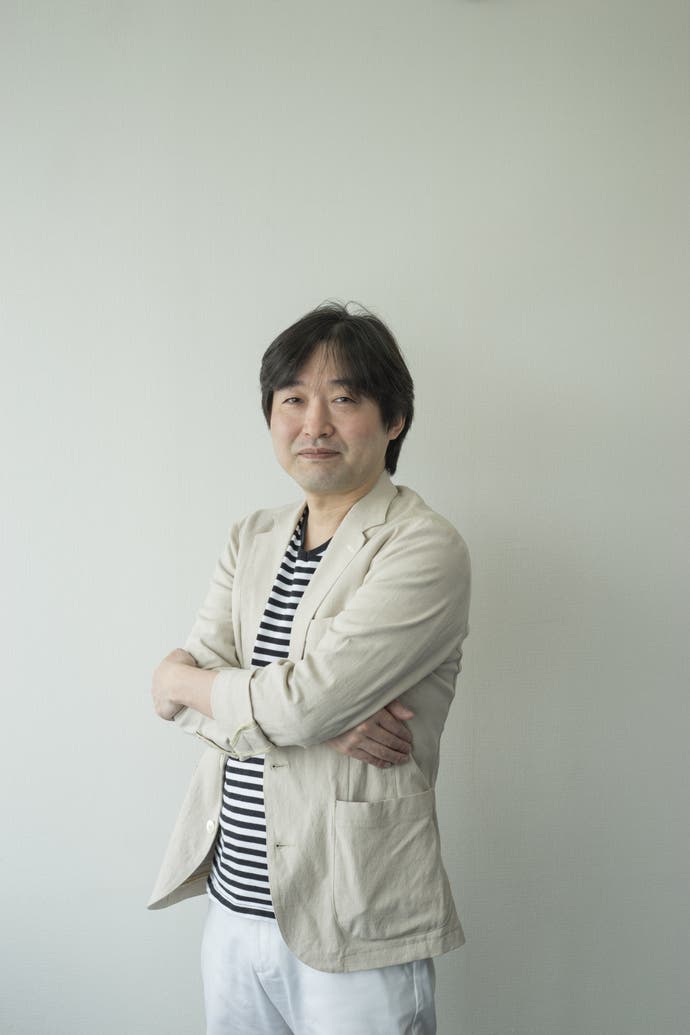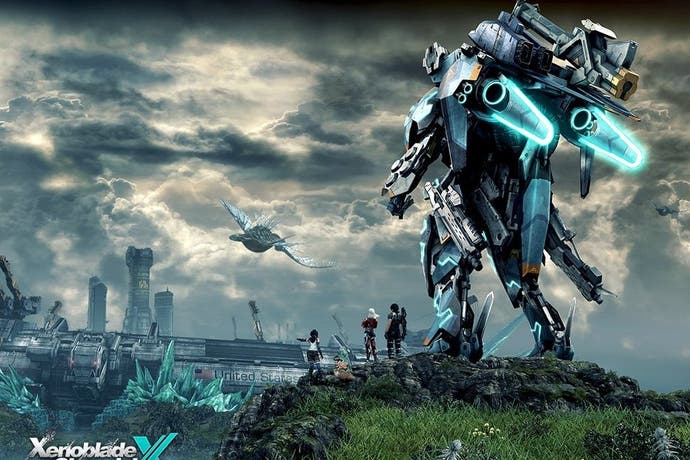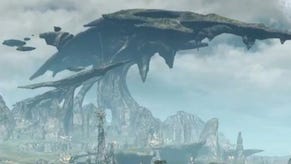Takahashi's castle: An RPG master's journey from Final Fantasy to Xenoblade
The Chronicles of Tetsuya Takahashi.
It's not enough for a video game to 'sprawl' anymore. Where once the size of a virtual world provided a somewhat useful measure of its creators' effort and ambition, nowadays, entire galaxies can blossom from a few seemingly throwaway lines of code. If ever you grow tired exploring one of Minecraft's worlds, simply load a fresh one; the next unique arrangement of hills, trees and caverns will keep you busy for months. There is, in fact, already more virtual real estate in video games than humans will ever be able to chart or fathom.
Considering this surplus of space, the world of Mira, home of Xenoblade Chronciles X, which launches in the west in November, should be unremarkable. Except that its creator, Tetsuya Takahashi has always brought a great deal more than mere expanse to his worlds. 2011's Xenoblade Chronicles, for example, takes place on the torsos of two miles-long colossi, whose bodies are overgrown with moss, reeds and lakes. You trek along their vast arms and knees. Look up and you might see a shoulder waiting in the misty distance. It's the kind of virtual world that even a room full of monkeys loading procedurally generated landscapes for an infinite amount of time could never produce.
Mira stretches dizzyingly from the smog and spires of its capital city, New LA, across verdant plains filled that scoop up to form stratospheric cliffs. It sprawls, but, crucially, it also entrances. That's what makes it so beguiling. It was not, however, easily arrived at. For Takahashi, building a place of such scale and ambition has been a career-long quest. His first assignment as a new recruit at Square-Enix in the early 1990s was nothing more than a dry-stone wall, a strip of art just a few pixels thick. The wall, which was used in the first game on which he worked, Final Fantasy 4, used up less processing power than a single blade of Xenoblade Chronicles X's grass. It may not have had much in the way of sprawl, but Takahashi's wall did a lot for the artist, bringing him to the attention of Hironobu Sakaguchi, creator of the Final Fantasy series, who noticed in him a unique and, as Sakaguchi put it in 2014, "impressive" talent.
Sakaguchi and Takahashi came to have a close working relationship. The young artist was instrumental in creating Final Fantasy 6's opening, when a line of bipedal tanks trudge through the snow en route to a remote village. Sakaguchi had intended for these so-called Magiteks to appear in the intro exactly as they did in the game, as rather squat, shuffling sprites. Takahashi had other plans, however, and drew the machines from behind, where you could see their height and mechanical heft. He made them walk into the screen using the Super Nintendo's Mode 7 effect. The scene, combined with Nobuo Uematsu's 'Omen' theme is one of the series' most memorable. The late Nintendo president Satoru Iwata once asked Sakaguchi whether Takahashi's work improved on the dirctor's vision. "Right," said Sakaguchi. "And it hurt a bit to admit it."
Takahashi was hired to work at Square-Enix as an artist, but soon showed himself to be usefully flexible. "Taka-chan has always had a talent for motivating people and bringing them together as a team," said Sakaguchi. These leadership qualities came into play midway through the development of Final Fantasy 7, when Takahashi called his boss into a meeting room. "I recall going to see Sakaguchi-san and telling him that I was looking for a new challenge," Takahashi said, in 2014. Sakaguchi was sympathetic to his colleague's request and helped assign the young director a team. After he did so, Sakaguchi said he "felt a little lonely." As soon as Takahashi was freed from Final Fantasy's strictures, Sakaguchi recalls that his friend's desk became covered in Gundam models. "It was then that I realised he'd always wanted to work on this kind of thing," says Sakaguchi.

Xenogears, as Takahashi's game would become known, was an ambitious sci-fi Japanese RPG that combined a story about political intrigue and a corrupt state religion with giant robot fights. Viewed ungenerously, it's a confused hotchpotch of play styles that lacks focus and consistency across its sixty hours of winding, occasionally incomprehensible adventuring. Fans, however, point to a game that offers deep, multiple battle systems and a seemingly endless parade of cute narrative and gameplay set-pieces. It's also one of the first 3D Japanese RPGs not to use pre-rendered backgrounds. Rather, everything in the game is rendered in polygons. "I felt that the company needed to develop knowledge on how to utilise 3D in a different way from that of Final Fantasy 7," says Takahashi.
There were significant challenges in this aim. In 2007, reflecting on his early time as a team leader, Takahashi said: "I had a strong sense that I could do this, that it was going to be alright. Now when I look back at it, I realise that if I'd done more to inspire that same feeling in my staff, it would have been easier." Takahashi's inexperience as a team-leader combined with the inexperience of his staff. "90 per cent of my team were actually new kids who didn't know the first thing about 3D. The most difficult thing was the psychological side: helping people adjust to the team, talking through their worries and concerns with them, and so on. It was then that I realised that Sakaguchi-san had been dealing with this kind of thing all along."
Not all of Xenogears's problems could be fixed by diplomacy. The game's ambition clearly outstripped its budget. As such, the team was forced to tell the second half of the story through a series of montage cutscenes. Squaring vision with reality has been a defining issue during Takahashi's career. His grand six-part epic Xenosaga, the first game he worked on after he left Square in October 1999 to start a new company, Monolith Soft, was similarly cut short after just three of its planned six episodes.
History seemed set to repeat with the Nintendo Wii's Xenoblade Chronicles. Midway through the project the team encountered a raft of difficulties and, realising they would miss the launch deadline, a deflated Takahashi met with Hitoshi Yamagami, the Nintendo producer who oversees RPG development, to suggest a list of deadline-aiding compromises. Yamagami rejected the plan and told the designer: "You've come this far. You should see it through to the end. I'll convince the others at the company."
It was an act of commercial benevolence that gave Takahashi and his team what they needed to carry on. Where, previously in his career, publishers had baulked missed deadlines and cut Takahashi vision short, Nintendo demonstrated a belief in the team that consequently inspired the best in them. Xenoblade Chronicles launched to widespread acclaim in 2011. It is one of the strongest JRPGs of the past 15 years, a game that revitalised a genre that has felt increasingly irrelevant when set against its ever-more ambitious Western counterparts. After so many difficult projects, Takahashi says that it was the game that proved he could deliver on the ideas he saw in his mind, one that also showed the on-going potential of the form.
After that success Xenoblade Chronicles X, by contrast, has been built with a slightly different mind-set. "We wanted to achieve something that was more about us as Monolith Soft being able to create an open world system, to implement online features, and to transition into the high definition era" he tells me. Numerous lessons from the development of Xenoblade Chronicles equipped the team for achieving these goals, even within the difficult restrictions the studio made for itself (they did not, for example, use any middleware to quicken production).
"With that game we'd learned how to create locations that are fun to explore on a budget," he explains. "If we had no restrictions at all in terms of costs, then for example we could easily make a varied and interesting map simply by creating textures and models for four or five different to use in a single 20km squared area. But within restrictions we had the difficult task of creating varied and fun locations using just the textures and models for a single kind of environment."
What's immediately clear when talking to Takahashi is his fiery self-belief, the kind that anyone would surely need to embark on the kinds of projects he makes, usually against all odds. "Basically, I'm the kind of person who always believes they are right, so I never doubt my decisions during a project," he says, with a smile. "Of course, after a project ends there are times when I look back and see things I could have done differently. There are also some decisions that are not easy to make. Like when one person would be happy with a decision, but someone else would not. Facing such decisions where there is a trade-off is all part of creating something. Ultimately you have to rely on your intuition. I try to make decisions not only considering the immediate consequences, but also considering where Monolith Soft is heading in the future."
Takahashi turned 50 earlier this month. It's a milestone that appears not to have dulled his irrepressible ambition. "My goals still lie ahead of me," he says, defiantly. "I feel like now that Xenoblade Chronicles X is done I'm finally standing on the start line." He has no plans to retire or even, as he put it to Iwata last year, to move away from the practicalities of game design. "Something I've felt recently is that a lot of people of our generation have taken on roles as producers, and that they've actually been too hasty to distance themselves from the actual game development process," he said at the time. "If you look at films or animation, people in their fifties or sixties remain very active. If we retire from actually making games, that spirit of craftsmanship won't be handed down to the next generation. That's why I think it's better that we maintain a hands-on role in the game development process."
For Takahashi, the aim of this endeavour is to compete at a global level in the games market. "Japan is a peculiar country in the sense that - and this not only applies to games, but almost all cultural output like music, movies and books - we tend to look only within Japan for sales and recognition," he says. "There is a tendency to focus only on Japan, and not enter the competition on an international level. As an island country we have a rather closed cultural environment, but as creators we will only lag behind this way. On the other hand, many of our industrial products are still standing their ground on the global market. We at Monolith Soft don't intend to back down from this challenge. We would like to keep our scope open in order to reach as far as we can."
Takahashi's enthusiasm about game-making remains keen and, in contrast to the attitude of some of the more weary and jaded Japanese creators of his age, infectious. "There are reasons to be excited all around us," he says, leaning forward. "Many of the games developed in Europe or in the States provide an exciting target. They inspire me. Back when I was figuring out what to do with my life the early computer games coming onto the market caught my attention. I saw both the immense potential for development of computers and the interactive possibilities they could provide. I felt a day could come when computer games would surpass other existing cultural outputs. That's why I decided to join this industry. It's why I'm still here."











